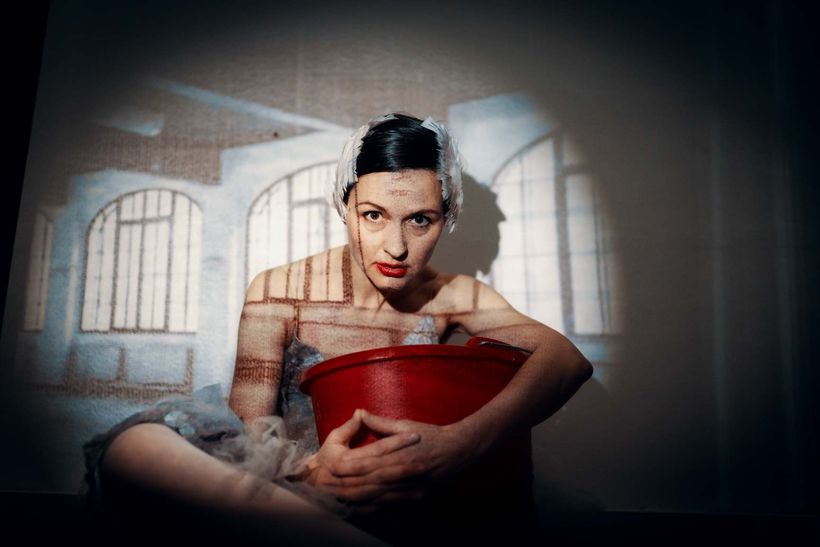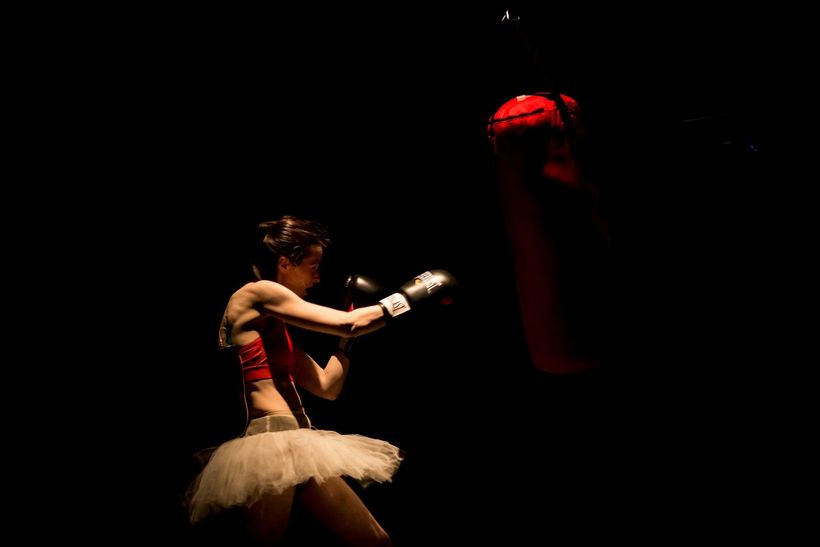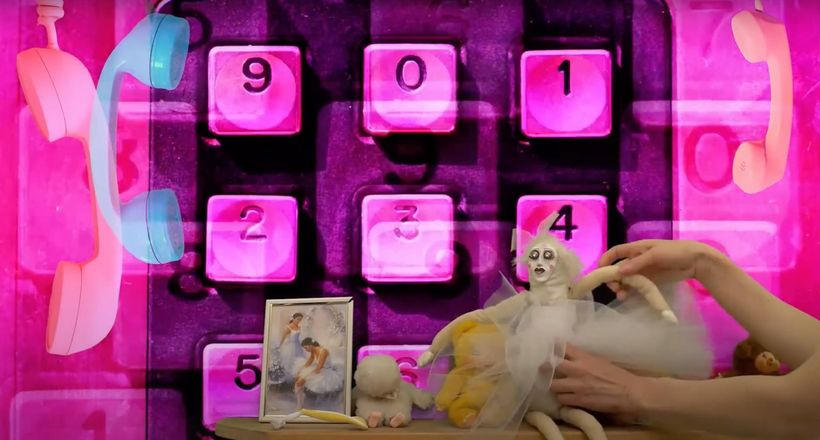metaBALLERINAS – The Importance of Raising Your Voice
You may have felt like having had enough of Baletky (Ballerinas). The book of choreographer and performer Miřenka Čechová had provoked heated debate even prior to its publication, following the mere release of its annotation and a few interviews. And yet, in less than a year afterward, the author has elected to transmogrify both the theme of the publication and the reaction to it into a multimedial performance. Thus, here we are with metaBALETKY (metaBALLERINAS). And it is good news.
Miřenka Čechová makes no secret of the impetus to create this new production being her shock at the response from a certain segment of the professional dance world to her printed work, which has later given her a panic attack, as well as her astonishment at her persistent state of hopelessness in the face of a certain kind of power that factually has lost control of her but remains capable of triggering her subconsciously, even after so many years of her conservoire post-graduation. So was I myself surprised at it, I must add, as this artist comes across as being self-confident and lavished with success in her niche. The more so do I applaud her for having had the guts to plunge into the topic once again, dissecting it into microparticles and moulding it into an artistic shape of a partially live performance, in which case she has put more skin in the game, and more directly, than in the case of the book. This production is of much greater import in the bigger picture because it represents an experience-based confrontation with the system, power, and fear shared by many people. It specifies the kind of rhetoric and strategies by her own account applied to tuition at a conservatoire that could have potentially affected some students to the point of trauma.
Study at a selective school
The central storyline stems from her publication in prose on the autobiographical side that centers on the study at a conservatoire in the nineties. It is a story of great love for dance or ballet that had led a ten-year-old girl from the borderlands to a selective school in the capital city. It is an account of a collision with the system of tuition that was diametrically opposed to her prior experiences at primary art school, and of growing-up in the nineties, moreover at a boarding school. And, above all, it is a narrative of "losers", or students who did not become ballet dancers eventually, thus, according to Čechová, having failed in the eyes of the school, the society, and mainly in their own. The hybrid-style production combines live streaming with pre-shot film material. The imagery is divided into twelve scenes and depict more or less chronologically selected passages from her novel. Emphasis is placed on the inner motivation of the female protagonist in the face of the outer, institutionalized "motivation".
For example, in the introduction we see sort of a home video in which Čechová, dressed in a sweatsuit and on the street, replays her favorite parts taken from famous ballet performances. Cut-ins show these sequences on film as danced on world ballet scenes, which had enchanted the heroine and marked the inception of her longing to become a ballerina. Despite her street interpretation coming across as comical in places, I do not think that it was meant as a parody or ridicule toward ballet gems – rather, it refers to a childlike naivety.
 This naivety is still palpable in the scene of her arrival at the boarding school when she, unpacking her suitcase, pulls out her stuffed toys, "magical" doll-dancer and novels on ballerinas. At the same time, future imperatives on clothing, food, and expected hard work (plasters and desinfectants) are creeping in. This theme is futher expanded upon in the depiction of classical ballet training full of critical comments about the body on the teacher's part, weighing on Mondays, counting callories, cheat meals and a subsequent solution in the form of sticking a finger down one's throat.
This naivety is still palpable in the scene of her arrival at the boarding school when she, unpacking her suitcase, pulls out her stuffed toys, "magical" doll-dancer and novels on ballerinas. At the same time, future imperatives on clothing, food, and expected hard work (plasters and desinfectants) are creeping in. This theme is futher expanded upon in the depiction of classical ballet training full of critical comments about the body on the teacher's part, weighing on Mondays, counting callories, cheat meals and a subsequent solution in the form of sticking a finger down one's throat.
The imagery evokes a great strain on the body, accompanied by a hard drill, and yet what makes itself constantly felt in the commentaries is the female protagonist's determination to make it and keep it up, her worries that her efforts will go unrecognized, and her memories of performances she has partaken in. That said, there is her emerging resistance to the system, her need to speak up or protest against continuous silencing on the part of authorities. In contrast to such total body and mind control devoid of a possibility for self-expression, the heroine finds refuge on the dance club scene, wherein she has come to feel emotions, energy, euphoria and freedom.
The Meta-level
The above-mentioned scenes of a narrative character are supplemented by some kind of video clips in which Čechová sublimates the heroine's feelings into a poetic language, rhythm and movement. She transforms the ballet drill into tough rap on the streets of a housing estate, embodying her inner doubts and eating disorder in a song and dance of a sad ballerina attired in a stuffed costume.
While the film passages can be called a fiction in which Čechová acts as both a narrator and a protagonist in the story of Baletky, the live shots represent that meta-level on which she addresses that which this ficiton has amounted to in reality. She is straightforward in sharing her motivation behind the creation of this production, her ideas and feelings; she reads aloud selected negative responses to her book (oftentimes written before its very publication) as well as reactions of people who share experience akin to hers and the book meant catharsis to them. Not only do anonymous characters meet with criticism, but so does the broader system of culture and education for being unable to address the issue openly and productively. This kind of a prod is represented by a live scene of a panel discussion about study at dance conservatoires in which the moderator emphasizes a positive outcome of the study while admitting that a survey of students has not been conducted due to time pressure. Authoritative figures of choice, seated at the table with evocatively huge masks on (strikingly reminiscent of those worn in a performance called Antikódy, Anticodes), then utter some scathing comments on the quality of young dancers and on the fact that "ballet cannot be done by anyone". It seems like a similar panel discussion may have become the initial impulse for her to publish her novel. It is fascinating that her book had a much greater impact on public debate than several professional conferences and research conducted by the Theatre Institute (Divadelní ústav) altogether. Such is the power of art.
The closing shot reveals the author's anxiety aroused by criticism which she came under in relation to Baletky: In the dark there appears a huddled body lying on the floor, paralyzed. A way out can be found in the understanding of what happened, of her own reactions and feelings – there comes to her rescue philosopher Alice Koubová, who then starts speaking (and filming). In her particulat, metaphorical vernacular, she specifies and analyzes the problem; she offers no quick fix, but expresses some hope that the dancer will be able to cope in the end. Čechová has elected to tackle it actively, in a rather fighting spirit: This time, after many an escape from the issue, she, considering the proverbial "fight or flight", has opted for "fight", putting on boxing gloves and launching herself at it.
Art vs. reality
In terms of form, the production metaBALETKY is an ambitious, original and elaborate work of art. The video, animation, and direct speech all address the viewer, who, sitting in front of a screen, does not feel like missing out but is directly drawn into the performace thanks to the possibility of posing questions and making comments. Miřenka Čechová has drawn inspiration for this format from recent Isabella Rossellini's artistic creation, having called for collaboration an interdisciplinary team of experts such as directress Janka Ryšánek Schmiedtová, female dramaturge Martina Kinská, composer Martin Tvrdý and DJ Mary C, who played live music during the production.
The pre-shot narrative scenes are filmed minimalistically in several places: a boarding room, a dance studio, a club, outdoor spots of a shabby housing estate. The video maker, Tereza Vejvodová, combines a film camera with a compact camera that gives the imagery the right patina of the nineties. Linda Arbanová's multicolored animation adds the finishing touches to the playful and fragmentary form of this work of art.
In the narrative scenes, the choreographer and performer uses a rather illustrative movement language and pantomime as an accompaniment to the narrator's voice – the film speaks to the viewer as a whole, made up by filmic, musical, kinetic and vocal components in unison. By contrast, in the live dance scenes, there is more of abstraction as the performer transforms her feelings directly into a corporeal expression, making these parts the most physically expressionistic.
Finally, there arises a question of whether this work of art contributes anything new to the debate previously provoked, or whether it just continues inflaming animosity between individual segments of the dance world. It surely could be argued that, the commentaries of choice and the overall stance on the dance conservatoire are both very one-sided in that the artist focuses on the negatives while almost overlooking the positives or nice experiences, the latter of which many students have also been through at the school. Nonetheless, both Baletky and metaBALETKY are works of art unobliged to be balanced, correct, and multisided in their perspective. It is a question of an individual viewpoint in a specific time and place, which is to be constantly reminded. Still, in metaBALETKY, Čechová concentrates on a rather general theme of power and fear, trying to analyze a certain rhetoric of the system that could have led her and other students to self-destructive tendencies, in which, in my opinion, she has succeeded. Possible insults and body-shaming represent but the tip of an iceberg, as the issue goes much further. It is a vernacular in which emphasis is or was put on the principle of the superiority of classical ballet and its authorities, drill-focused inducements, too little space for individual self-expression, etc. Hierarchy and uniformity are a legacy of ballet per se, like it or not; hard work is an essential prerequisite for the engagement in this demanding profession, which certainly cannot be joined by anyone. There is a requirement of unconditional respect for the institution and authority, which is okay if it is gained by a respectful treatment and model behavior, not by a downright execution of power. Above all, this respect should be expressed mutually, relative to the bodies and souls of students as well.
The combination of abovementioned conditions of the ballet education, which Miřenka Čechová has addressed in writing, certainly is a heavy load on an adolescent who comes to such a school mainly out of love for dance and can be "crushed" if lacking in necessary psychical and physical predispositions. Not all girls and boys who at the age of ten commence their studies at a conservatoire will become dancers in a ballet ensemble – in fact, a higher percentage of them drop out of school. Whereas schools rightly boast of successful students, the stories of "drop-outs" are rarely heard of. That is not to say though that their experiences and lives are of lesser importance because of that. Reference to such aspects of dance education may, with luck, minimize the sense of failure and stigma relative to it. Of course, not everybody has only negative experiences when studying at a conservatoire, as the approach of individual institutions and pedagogues considerably differs, and so, as even Čechová herself admits, all in all, "it was not so bad" – the students also enjoyed a lot of nice moments and fun at the school. Owing to the survey we editors of Taneční aktuality are currently conducting (and which contains talks with students), I assume that, most institutions and pedagogues truly educate those in their care with respect and with the aim of preparing them for the profession as best as possible. This notwithstanding, it remains important to talk about such topic in public. For one thing, it starts a discussion on a professional level; for another thing, it brings an opportunity for self-reflection; and, above all, it could help many people cope with real trauma that they keep on carrying inside throughout life.
Written on the basis of an on-line stream on the 4th and 5th of May, 2021.
metaBALLERINAS
Concept, text and performance: Miřenka Čechová
Music: Martin Tvrdý
Live music: Mary C
Video: Tereza Vejvodová
Animation: Linda Arbanová
Directorial assistance: Janka Ryšánek Schmiedtová
Dramaturgy: Martina Kinská
Light design: Martin Špetlík
Costumes and make-up: Natálie Host, Andrea Gájová
Photography: Ondřej Košík, Vojtěch Brtnický
Scenography and stage set: Petr Boháč, Honza Tomšů
Project management: Barbora Faifr Repická
Film editing: Simona Donovalová
Live stream direction: Aneta Fodorová
Live stream: Lukáš Kurkin & LK production
Premiere: 4. 5. 2021, online
Translation: Sylvie Bermannová





